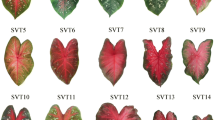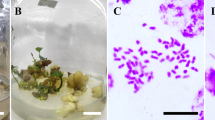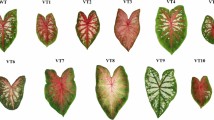Abstract
Caladium (Caladium × hortulanum Birdsey) is an important ornamental aroid that is valued for its long-lasting colorful foliage. Genetic improvement and cultivar development in caladium have been primarily achieved through sexual hybridization, and there is a strong need to explore in vitro-based approaches to generate novel phenotypic variations in caladium. This study was conducted to develop an efficient in vitro chromosome doubling technique for caladium, to assess the effects of chromosome doubling on caladium leaf morphology, and to identify promising caladium tetraploids for breeding. Leaf segments of ‘Tapestry’ caladium were pre-cultured in vitro, treated with colchicine, and then cultured to regenerate tetraploid plants. Out of 501 established plants, 56 showed considerable variation from the wildtype in leaf shape, color, coloration pattern, and/or thickness. Ploidy analysis showed that 48 appeared to be tetraploids, and the remaining eight appeared to be diploids. In two treatments with 0.1 or 0.2 % (w/v) colchicine for 4 days, 13.74 and 24.14 % of the regenerated plants were tetraploids. Caladium tetraploids exhibited round and thick leaves with thick petioles. These morphological changes were a reliable morphological indicator for visual screening for tetraploids in caladium. Based on observed morphological changes, the eight diploid variants were categorized into five variant types (VT1–VT5), and the 48 tetraploid variants were categorized into another five variant types (VT6–VT10). Most caladium plants in VT1, VT2, VT3, VT6, and VT7 showed much improved ornamental values and held potential as promising new selections for container and landscape performance trials and tuber yield tests. Nuclear DNA content and chromosome number analysis were conducted on 17 representative variants; results revealed the two diploid variants had gained one or two additional chromosomes, one tetraploid variant gained four additional chromosomes, and two tetraploid variants lost two or four chromosomes. These results demonstrate for the first time in caladium that in vitro induction of tetraploids is a very powerful tool for generating novel phenotypes for genetic improvement and breeding and that chromosome gain or loss is a common type of cytological variation in caladium.



Similar content being viewed by others
Abbreviations
- BA:
-
6-Benzyladenine
- CCI:
-
Caladium callus induction
- FCM:
-
Flow cytometry
- MS:
-
Murashige and Skoog’s
- NAA:
-
1-Naphthyl acetic acid
- PE-2:
-
Plantlet enhancement medium 2
- SD:
-
Standard deviation
- VT:
-
Variant type
References
Abdoli M, Moieni A, Badi HN (2013) Morphological, physiological, cytological and phytochemical studies in diploid and colchicine-induced tetraploid plants of Echinacea purpurea (L.). Acta Physiol Plant 35:2075–2083
Ahmed EU, Hayashi T, Zhu Y, Hosokawa M, Yazawa S (2002) Lower incidence of variants in Caladium bicolor Ait. plants propagated by culture of explants from younger tissue. Sci Hortic 96:187–194
Ahmed EU, Hayashi T, Yazawa S (2004) Auxins increase the occurrence of leaf-color variants in caladium regenerated from leaf explants. Sci Hortic 100:153–159
Bell ML, Wilfret GJ, DeVoll DA (1998) Survey of caladium tuber producers for acreage of cultivars grown. Proc Fla State Hortic Soc 111:32–34
Broertjes C, Keen A (1980) Adventitious shoots: do they develop from one cell? Euphytica 29:73–87
Cao Z, Deng Z, McLaughlin M (2014) Interspecific genome size and chromosome number variation sheds new light on species classification and evolution in Caladium (Araceae). J Am Soc Hortic Sci 49:449–459
Chen J, Henny RJ (2008) Ornamental foliage plants: improvement through biotechnology. In: Kumar A, Sopory SK (eds) Recent advanced in plant biotechnology and its applications. I.K. International, New Delhi, pp 140–156
Chen C, Hou X, Zhang H, Wang G, Tian L (2011) Induction of Anthurium andraeanum ‘Arizona’ tetraploid by colchicine in vitro. Euphytica 181:137–145
Chung MY, Kim CY, Min JS, Lee DJ, Naing AH, Chung JD, Kim CK (2014) In vitro induction of tetraploids in an interspecific hybrid of calanthe (Calanthe discolor × Calanthe sieboldii) through colchicine and oryzalin treatments. Plant Biotechnol Rep 8:251–257
Cohen D, Yao JL (1996) In vitro chromosome doubling of nine Zantedeschia cultivars. Plant Cell Tissue Org Cult 47:43–49
Comai L (2005) The advantages and disadvantages of being polyploid. Nat Rev Genet 6:836–846
Deng Z (2012) Caladium genetics and breeding: recent advances. Floric Ornam Biotechnol 6:53–61
Deng Z, Harbaugh BK (2006) Independent inheritance of leaf shape and main vein color in caladium. J Am Soc Hortic Sci 131:53–58
Deng Z, Harbaugh BK, Perez NA (2011) ‘UF-172’, a pink fancy-leaved caladium cultivar for large containers and landscapes. HortScience 46:132–134
Doležel J, Greilhuber J, Suda J (2007) Estimation of nuclear DNA content in plants using flow cytometry. Nat Protoc 2:2233–2244
Gantait S, Mandal N, Bhattacharyya S, Das PK (2011) Induction and identification of tetraploids using in vitro colchicine treatment of Gerbera jamesonii Bolus cv. Sciella. Plant Cell Tissue Org Cult 106:485–493
Gomes SSL, Saldanha CW, Neves CS, Trevizani M, Raposo NRB, Notini MM, Viccini LF (2014) Karyotype, genome size, and in vitro chromosome doubling of Pfaffia glomerata (Spreng.) Pedersen. Plant Cell Tissue Org Cult 118:45–56
Leus L, Eeckhaut T, Dhooghe E, Van Labeke MC, Van Laere K, Van Huylenbroeck J (2012) Polyploidy breeding in vitro: experiences with ornamentals. Acta Hortic 961:235–238
Liu XZ, Lin H, Mo XY, Long T, Zhang HY (2009) Genetic variation in colchicine-treated regenerated plants of Eucalyptus globulus Labill. J Genet 88:345–348
Liu S, Chen S, Chen Y, Guan Z, Yin D, Chen F (2011) In vitro induced tetraploid of Dendranthema nankingense (Nakai) Tzvel. shows an improved level of abiotic stress tolerance. Sci Hortic 127:411–419
Luckett DJ (1989) Colchicine mutagenesis is associated with substantial heritable variation in cotton. Euphytica 42:177–182
Murashige T, Skoog F (1962) A revised medium for rapid growth and bioassays with tobacco tissue cultures. Physiol Plant 15:473–497
Ogawa D, Ishikawa K, Mii M (2012) Difference in the polysomaty degree during fruit development among plants with different ploidy levels produced by artificial chromosome doubling of a pepper (Capsicum annuum) cultivar ‘Shishitou No. 562’. Sci Hortic 134:121–126
Pansuksan K, Sangthong R, Nakamura I, Mii M, Supaibulwatana K (2014) Tetraploid induction of Mitracarpus hirtus L. by colchicine and its characterization including antibacterial activity. Plant Cell Tissue Org Cult 117:381–391
Soriano M, Cistué L, Vallés MP, Castillo AM (2007) Effects of colchicine on anther and microspore culture of bread wheat (Triticum aestivum L.). Plant Cell Tissue Org Cult 91:225–234
Takamura T, Miyajima I (1996) Colchicine induced tetraploids in yellow-flowered cyclamens and their characteristics. Sci Hortic 65:305–312
Thao NTP, Ureshino K, Miyajima I, Ozaki Y, Okubo H (2003) Induction of tetraploids in ornamental Alocasia through colchicine and oryzalin treatments. Plant Cell Tissue Org Cult 72:19–25
Thongpukdee A, Thepsithar C, Chiensil P (2010) Somaclonal variation of Caladium bicolor (Ait.) Vent. ‘Jao Ying’ after in vitro culture propagation. Acta Hortic 55:281–288
van Tuyl JM, Merjer B, van Din MP (1992) The use of oryzalin as an alternative for colchicine in in-vitro chromosome doubling of Lilium and Nerine. Acta Hortic 325:625–630
Wilfret GJ (1993) Caladium. In: de Hertogh A, LeNard M (eds) The physiology of flower bulbs. Elsevier, Amsterdam, pp 239–247
Yang PM, Huang QC, Qin GY, Zhao SP, Zhou JG (2014) Different drought-stress responses in photosynthesis and reactive oxygen metabolism between autotetraploid and diploid rice. Photosynthetica 52:193–202
Yenchon S, Te-chato S (2014) Polyploidy induction of Dendrobium formosum by colchicine treatment in vitro. Acta Hortic 1025:81–88
Zeng SH, Chen CW, Hong L, Liu JH, Deng XX (2006) In vitro induction, regeneration and analysis of autotetraploids derived from protoplasts and callus treated with colchicine in Citrus. Plant Cell Tissue Org Cult 87:85–93
Acknowledgments
This study was funded in part by the Frederic C. Gloeckner Foundation, Inc., Florida caladium growers’ contribution, and the 2012 Florida Legislature Appropriation for caladium research. We thank Yinghong Wang for transplanting caladium plantlets and establishing them in the greenhouse, Alison Yang and Dr. Shunzhao Sui for assisting flow cytometry analysis, and Joyce Jones and Gail Bowman for caring caladium plants. We are especially grateful to Dr. Jaroslav Doležel (Institute Experimental Botany, Olomouc, Czeck Republic) for providing rye seeds and to the University of Florida’s Interdisciplinary Center for Biotechnology Research for access to its flow cytometer.
Author information
Authors and Affiliations
Corresponding author
Rights and permissions
About this article
Cite this article
Cai, X., Cao, Z., Xu, S. et al. Induction, regeneration and characterization of tetraploids and variants in ‘Tapestry’ caladium. Plant Cell Tiss Organ Cult 120, 689–700 (2015). https://doi.org/10.1007/s11240-014-0636-8
Received:
Accepted:
Published:
Issue Date:
DOI: https://doi.org/10.1007/s11240-014-0636-8




